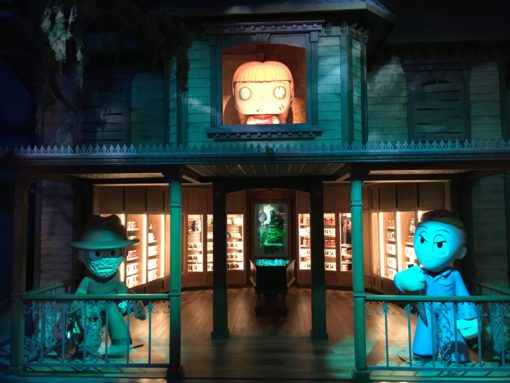Andy Warhol predicted, “Someday, all department stores will become museums, and all museums will become department stores.” If that’s the case, then there’s a new museum in Hollywood that needs to be added to the list of L.A.’s tourist attractions. Funko, a company specializing in urban vinyl toys, bills itself as ”one of the leading creators and innovators of licensed pop culture products,” and in November of 2019, they opened their newest retail space on Hollywood Boulevard. Still, as obvious as the cash registers are, the uncognoscenti are excused for thinking they have arrived at a most excellent museum since the space is primarily designed to impress viewers with the monumentality of what appear to be Instagram-ready art installations. As part of Funko’s mission statement to “provide consumers tangible ways to take their fandom offline,” each different toy franchise features a life-size sculptural environment that encourages exploration; which of course reveals the shelves of merchandise. It’s crafty and remarkably similar to a museum, where one looks at unaffordable objects but can leave with a satisfyingly inexpensive facsimile.

Nightmare on Elm Street sales kiosk at Funko. Photograph by Anthony Ausgang
The art critic Peter Schjeldahl has pointed out that museums are the secular equivalent of churches, which explains the gravity characteristic of a museum experience. There’s interface but no interaction, and not understanding a work of art’s purported significance puts the viewer in a difficult place. Because when an artist or singular work of art is called “important,” things have suddenly gotten serious, and that encourages the casual observer to look for an anchor of normalcy in a sea of art rhetoric. Unable to calculate value outside of the museum’s rarefied atmosphere, the search is not for meaning, but for meaninglessness and the refreshing relationship one can have with something of no importance. Which is the appeal of Xu Bing’s piece 1st Class, included in the LACMA exhibition The Allure of Matter: Material Art from China. Probably the most accessible piece in the show, Bing’s massive faux tiger skin rug made of 500,000 cigarettes owes its appeal to the fact that there’s no mystery involved, just a shared enjoyment based on everyone’s understanding of what constitutes both tigers and cigarettes. Unfortunately, explaining Bing’s underlying concept (that fanatical smoking in China is a result of U.S. commercial imperialism) would probably lessen most people’s enjoyment of the piece.

Xu Bing, 1st Class, mixed media. Photograph by Andy Kitchen
Andy’s prophecy is a moot point now that a single location can serve as both a museum and a department store; witness the fully functional Louis Vuitton boutique included in Takashi Murakami’s 2007 exhibition at MOCA. The alchemical element that makes such a thing possible, is fun; the same fun that encouraged customers at the Murakami show to pay $300 over the price of similar items at Vuitton in Beverly Hills. So, the point of Funko isn’t so much that one will have a good time there; it’s that one will have an even better time if more money gets spent. Plus, the more spectacular the offline retail environment, the more online exposure Funko gets through its customer’s social media accounts. Check out the Harry Potter kiosk that features an IG-ready table at which one can be photographed with cartoonish figures of the movie’s three main characters. Which is probably more fun than standing under a 340-ton boulder with a selfie stick at LACMA.

Harry Potter sales kiosk at Funko. Photograph by Anthony Ausgang
Funko, 6201 Hollywood Blvd Ste 100, Los Angeles, CA 90028, (213) 462-3600, https://www.funko.com/


